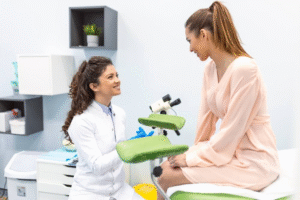Introduction
A Pap smear, or Pap test, is a simple screening procedure used to detect abnormal cells in the cervix, the lower part of the uterus. It has revolutionized women’s health by enabling early detection of cervical cancer. Routine Pap smears have significantly reduced the incidence and mortality associated with cervical cancer. This test is essential for reproductive health and should be part of every woman’s preventive care routine. In this article, we’ll explore how the Pap smear works, why it’s important, and what women can expect during the process.
Early Detection of Cervical Cancer
Cervical cancer develops slowly and is often preceded by changes in cervical cells. A Pap smear identifies these changes, allowing for timely treatment before they become cancerous. Early-stage cervical cancer has a survival rate of over 90%, emphasizing the importance of regular screening.
Identifies Precancerous Conditions
The test is not just for cancer detection but also for finding precancerous conditions like cervical intraepithelial neoplasia (CIN). These cell changes can be treated early with minor outpatient procedures, preventing cancer entirely.
Part of Routine Women’s Health Screening
Most gynecologists recommend starting Pap smear tests at age 21 and continuing every 3–5 years, depending on age and history. The procedure is quick, generally painless, and can be combined with pelvic exams and HPV testing.
Role in HPV Detection and Prevention
Human Papillomavirus (HPV) is a major risk factor for cervical cancer. While a Pap smear doesn’t detect the virus directly, abnormal results often prompt follow-up HPV testing. Early detection of HPV-related changes helps in close monitoring and timely intervention.
Safe, Simple, and Inexpensive
The Pap test is one of the most accessible and cost-effective medical tests available. It usually takes less than 5 minutes, involves minimal discomfort, and doesn’t require anesthesia or recovery time. For its simplicity, the life-saving potential is enormous.
Guidelines for Pap Testing
According to health organizations:
- Ages 21–29: Pap test every 3 years
- Ages 30–65: Pap test every 3 years or every 5 years with HPV co-testing
- Over 65: May stop testing if history of normal results
Women with certain risk factors, such as HIV or a history of abnormal Pap results, may need more frequent testing.
Emotional Reassurance and Health Planning
Regular Pap smears provide peace of mind. Knowing your cervix is healthy reduces anxiety and empowers you to plan confidently for pregnancy or other health decisions.
Table: Benefits of Regular Pap Smears
| Benefit | Explanation |
|---|---|
| Detects abnormal cells early | Prevents progression to cancer |
| Reduces cervical cancer deaths | Increases survival with early detection |
| Monitors HPV-related changes | Triggers timely treatment and follow-up |
| Reassures overall reproductive health | Encourages preventive care habits |
What to Expect During a Pap Smear
- Performed during a pelvic exam
- A speculum is inserted to access the cervix
- A small brush collects cervical cells
- The sample is sent to a lab for analysis
Results are usually available within a week. If abnormalities are found, further tests like colposcopy or biopsy may be recommended.
Conclusion
The Pap smear is a powerful and simple tool in gynecology that helps save lives through early detection of abnormal cervical cells. Regular screening, even when you feel healthy, is critical. Every woman should understand the value of the Pap test and commit to regular gynecological care to maintain reproductive health and prevent disease.















